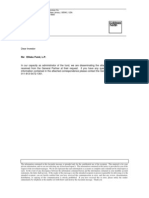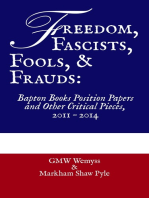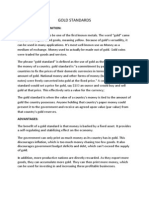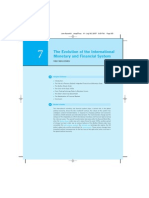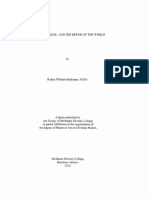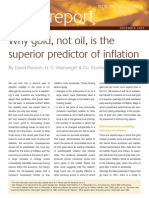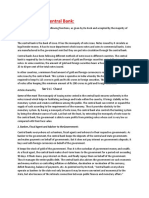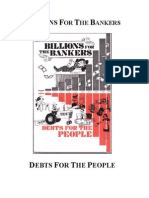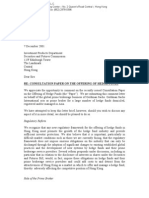Oracle Money Laundering Primer
Oracle Money Laundering Primer
Uploaded by
Lawrence A HunterCopyright:
Available Formats
Oracle Money Laundering Primer
Oracle Money Laundering Primer
Uploaded by
Lawrence A HunterCopyright
Available Formats
Share this document
Did you find this document useful?
Is this content inappropriate?
Copyright:
Available Formats
Oracle Money Laundering Primer
Oracle Money Laundering Primer
Uploaded by
Lawrence A HunterCopyright:
Available Formats
An Oracle White Paper October 2009
Hedge Funds and Anti-Money Laundering
Hedge Funds and Anti-Money Laundering
Executive Overview
A combination of secrecy, weak regulation, and rapid proliferation make hedge funds a very attractive vehicle for money launderers. This white paper describes how hedge funds fit into the overall lifecycle of money laundering; the history of money laundering regulations and how this is shaping the face of the hedge funds industry today; and new regulations such as the USA PATRIOT Act and how hedge funds are affected by these developments. Oracle Financial Services employs several advanced detection algorithms that are well-suited for finding money laundering in the layering and integration stages, including Link analysis, sequence matching, and outlier detection.
Introduction
The financial services industry is striving to close all loopholes potentially available to launderers. One investment vehicle that continues to receive close scrutiny is the Hedge Fund. These funds, or Private Investment Companies, operate under certain exemptions from registration under the Securities Act of 1933 and the Investment Company Act of 1940 as well as from the U.S. Securities Exchange Act of 1934 and U.S. Investment Advisors Act of 1940. To maintain these exemptions, hedge funds must meet specific guidelines regarding their structure, clientele, and operation. As non-public offerings, these funds are exempted from compliance with the registration and prospectus delivery requirements. They are also prohibited from advertising, so fund managers must rely on word of mouth or existing relationships to attract investors. Most funds are established as private investment partnerships, strict limits regarding the number of investors are imposed on each fund, and each investor must meet minimum income and net worth standards since funds are open only to qualified purchasers or accredited investors. Even though fund managers or administrators often know their customers through preexisting relationships, they must gather background information on potential investors to determine whether the investors meet
Hedge Funds and Anti-Money Laundering
minimum requirements. Nevertheless, investors often use intermediaries who do not divulge their identities to the fund managers. Offshore funds, or funds located outside the United States, are created for investments by nonU.S. investors and certain U.S. tax exempt investors. These funds are frequently managed by U.S. fund managers, execute securities transactions on U.S. exchanges, and apply strategies similar to U.S.-based funds. However, all administrative and audit activities must be conducted offshore for the fund and its investors to avoid certain tax and Internal Revenue Service (IRS) reporting obligations. For example, domestic hedge funds have to file returns with the IRS that identifies all investors while offshore hedge funds are not subject to this requirement. While it appears that domestic hedge funds will be subject to the Uniting and Strengthening America by Providing Appropriate Tools Required to Intercept and Obstruct Terrorism (USA PATRIOT) Act, offshore funds are subject to the securities laws and regulations imposed by the jurisdiction in which they are domiciled. Many of these jurisdictions have relatively lax anti-money laundering standards, although they are urged to adopt international anti-money laundering policies. Where such policies are lacking, it is difficult to ensure that sufficient information about the client or clients source of wealth is obtained. Funds are set up as a limited partnership (LP) with the fund manager acting as the general partner and organized as a limited liability corporation (LLC), a LP, or subchapter S corporation (S Corp). The investors are brought in as limited partners whose liability is equivalent only to the size of their investment. Investor funds are pooled by the manager and returns are paid out in proportional shares. Therefore, it is very difficult to track the source of funds used by the hedge fund. Funds of funds further clouds these issues and increases the opacity inherent in such investment vehicles. Due to their relative profitability in the current investment environment, hedge funds are experiencing an increase in popularity, particularly for nontraditional investors such as corporations, pension funds, private banking clients, and insurance companies. Money
Hedge Funds and Anti-Money Laundering
launderers commonly use shell companies to hide their activities, and the proliferation of nontraditional investors makes launderers shell companies stand out less.
1
The number of available funds is growing as well, and broker-dealers are turning to these vehicles in greater numbers since they provide tremendous opportunity to generate large profits for fund managers and firms. Concurrently, funds looking to increase their potential customer base are beginning to decrease minimum investment limits from US$1 million to as little as US$25,000. However, as funds get bigger, it is more difficult for them to invest in a manner that allows them to out-maneuver the market in the same way they could when they were small, which limits profitability. In addition, as funds grow in size, the complexity and difficulty of managing a large asset base also increases. Therefore, large funds invest in small funds and close funds to new investorsleading managers to open new funds.
McKenzie, Mark-Anthony. Growth in the Global Hedge Fund Industry and Due Diligence of Offshore Hedge Funds. www.planethedgefund.com/articles/caymenislands, 2002.
Hedge Funds and Anti-Money Laundering
HEDGE FUNDS AND THE MONEY LAUNDERING LIFECYCLE
There are three steps in the money laundering lifecycle, and hedge funds are more likely to be used in the later steps than the earlier ones. Placement. Getting dirty money into a legitimate financial system. Often the dirty money is in the form of cash or cash equivalents (money orders, travelers checks, cashiers checks). Layering. Moving the money around to disguise its true origin. This often involves many transactions intended to distance the money from the original depositor. Integration. Creating some plausible explanation for where the money came from. For example, a fake business may be the explanation for the source of the money. This often involves mixing laundered money with legitimately earned money.
Most mechanisms for stopping money laundering focus on the placement step because it is the easiest step in which to catch launderers. Federal laws require a Currency Transaction Report (CTR) to be filed for cash transactions over US$10,000. Logs are kept for money order purchases over US$3,000. Computer systems can find accounts that appear to be deliberately smurfing right below the US$10,000 or US$3,000 thresholds or structuring their deposits to avoid the reporting requirement. Computer systems can also find accounts that are depositing large amounts of cash over a short period of time. Still, these laws, policies, and systems do not stop all the money from entering financial institutions. Hedge funds are more likely to be used late in the layering step or as an integration mechanism. This is due to various characteristics of hedge funds and how they are normally used. Hedge funds usually deal in large amounts of money. The minimum opening deposit has historically been US$1 million, and although minimums are falling, they are still relatively large. Hedge funds would not be a good vehicle for making frequent deposits of small amounts of money because this behavior is not normal for hedge funds and would stand out. Thus, hedge funds are not likely to be used in the placement stage. Hedge funds usually do not deal in large amounts of cash and cash equivalents. This behavior would stand out in a hedge and would draw attention. Another reason why hedge funds are not a likely vehicle in the placement stage. Hedge funds have restrictions on withdrawal of money. Money can only be withdrawn monthly, quarterly, or even annually. In the early stages of layering, it is common to quickly move money through many accounts in a series of rapid transactions. Hedge funds are not conducive to this rapid movement of funds and therefore are unlikely to be used early in the layering step. Since much secrecy surrounds hedge funds and their returns, the growth in hedge funds provides a great plausible explanation for the origin of money. When a launderer withdraws money, it can be attributed to wealth growth that is difficult to trace or refute. This makes hedge funds easy to use in the integration step.
Hedge Funds and Anti-Money Laundering
The launderer may not be interested in using the money right away; he may be interested in stashing the money away for use years later. In this situation, the integration step simply involves investing the money and waiting. Passage of time gives the money a shade of legitimacy. Since hedge funds normally deal in large sums of money often from all around the world, they make great final repositories for money launderers money.
The following example illustrates how a hedge fund can be part of a larger money laundering scheme. A cocaine distributor has $4 million in cash he needs to launder. He has one hundred different checking accounts at various banks opened under false names. He and his employees deposit the $4 million into the accounts over the course of a couple weeks. Because all the deposits are about $5,000 and are spread out over time over various branches, no CTRs are filed, and no suspicions raised. The money has been successfully placed into the financial system. The money is then consolidated from the one hundred accounts into five central accounts using a combination of checks, journals, and wire transfers. From the five accounts, the money is further consolidated into an offshore account in the Cayman Islands. It is then wired to another account in Jersey and further wired to an account in the Philippines. Finally, the $4 million is used as an opening deposit at a new hedge fund. The money is channeled through an intermediary and supposedly comes from a wealthy Asian business executive who wants a higher rate of return than he believes he can get with traditional investments. The hedge fund is eager to recruit new investors and does not want to turn any money away. They take the Asian business executive story at face value and do not dig too deep to verify that the business really exists. The layering step is complete; the money has been distanced from its criminal origins. The launderer leaves the money in the hedge fund, and after two years it has grown to $7 million. At this point the launderer withdraws $1 million and retires to live in style. If anyone questions the origin of his funds, he has paperwork to show that hes living off the large returns from a hedge fund. The layering and the passing of time are sufficient to cloud the origin of the original investment. The integration step is complete. The drug distributor is enjoying his illegal gains and has a plausible explanation for its origin.
MONEY LAUNDERING AND TERRORIST ACTIVITIES
The process of terrorist financing is conceptually the reverse of traditional money laundering. In traditional money laundering, money from illegal activities is moved through the financial system, distanced from its origin, and made to appear legitimate. Financers of terrorist activities take money (often from legitimate sources such as a charity), move it through the financial system, distance it from its origin, and finally use it for illegal activities. So while the process as a whole is run in reverse, there are many similarities. In particular: The layering step is very similar to traditional money laundering. Terrorists need to distance terrorist activities from their funding source to keep the funding mechanisms from being shut down.
Hedge Funds and Anti-Money Laundering
A temporary repository is needed to aggregate funds until they are needed. Secrecy and anonymity are crucial for this, especially if the amounts of money are large.
Hedge funds provide the secrecy and anonymity needed for these types of money movements. Investigations have shown that terrorists often operate on very low budgets. Historically, there may not have been enough money in terrorist operations to meet the initial US$1 million minimum, but as opening deposits drop to as low as US$25,000, hedge funds may provide the right combination of secrecy and minimum size to be used by terrorists. The following example illustrates how a hedge fund could be part of a larger terrorist financing operation. A terrorist group creates a front organization that operates as a charity dedicated to poverty relief for a certain ethnic group. The charity collects donations from wealthy individuals in a particular region interested in helping out that group of people. Some of the money actually does go for social services for the poor, but a large portion of the donations is funneled into the bank account of International Trading Company (ITC), a shell company. Another shell company Great American Consulting (GAC) sends false invoices to ITC for $100,000 for services supposedly performed by GAC. ITC wires the $100,000 to GAC, and GAC opens a hedge fund account with a low initial minimum. After the one-year lockup period, GAC can withdraw money monthly, and a few thousand dollars a month are used to support a terrorist cell in the United States.
HISTORY OF MONEY LAUNDERING REGULATIONS
In order to understand the current extend of money laundering, it is necessary to understand the laws that have shaped money laundering down through the years. As new regulations were added, launderers adapted their techniques to skirt new laws. The most common laundering techniques in use today are a direct response to laws enacted over the years. The Currency and Foreign Transaction Reporting Act (1) also known as the Bank Secrecy Act (BSA), and its implementing regulation, 31 CFR 103, is a tool the U.S. Government uses to fight drug trafficking, money laundering, and other crimes. Congress enacted the BSA to prevent banks and other financial service providers from being used as intermediaries for, or to hide the transfer or deposit of money derived from, criminal activity. Individuals who derive their income from illicit sources cannot explain the source of their wealth and therefore structure transactions in order to avoid the reporting requirements of the BSA. Initially this was accomplished by structuring currency transactions in amounts below the $10,000 reporting threshold. As financial institutions began reporting structured currency transactions, money laundering changed course. Launderers began purchasing monetary instruments and transferring funds electronically in increments below the $10,000 reporting requirement. The government countered these moves with the requirement that financial institutions record identifying information regarding the sale of monetary instruments and wire transfers in amounts of $3,000 or more. Once again money launderers sought new methods to disguise illegal monetary gains, and their transactions involving monetary instruments and wire transfers dipped below the $3,000 threshold. The launderers then began to bulk-ship currency
Hedge Funds and Anti-Money Laundering
and monetary instruments offshore to BSA and Financial Action Task Force (FATF) high-risk geographies. Money launderers also sought methods of investing funds that were less likely to detect or report their activity. Hedge funds, which are largely unregulated by the U.S. Securities and Exchange Commission (SEC), are a likely source for money launderers to exploit. However, a hedge fund and the hedge fund general partner would be defined as a financial institution in the BSA regulations. This theory took advantage of the very broad definition of financial institution in 31 CFR section 103.11(n) to characterize individual persons as financial institutions with a legal duty to file a CTR each time the individual engages in a transaction in currency (that is, a physical transfer of currency) in excess of US$10,000. This theory works best with helpful admissions by the defendant.2 Money laundering was codified in Title 18 Section 1956 and 1957 with the passage of the Money Laundering Control Act of 1986. Title 18 section 1956(a)(1) states that whoever, knowing that the property involved in a financial transaction represents the proceeds of some form of unlawful activity, conducts or attempts to conduct such a financial transaction which in fact involved the proceeds of specified unlawful activity. (A) (i) with the intent to promote the carrying on of specified unlawful activity; or (ii) with the intent to engage in conduct constituting a violation of section 7201 or 7206 of the Internal Revenue Code of 1986; or (B) Knowing that the transaction is designed in whole or in part (i) to conceal or disguise the nature, the location, the source, the ownership, or control of the proceeds of SUA; or (ii) to avoid a transaction reporting requirement under state, or federal law shall be sentenced to a fine of not more that $500,000 or twice the value of the property involved in the transaction, whichever is greater, or imprisoned for not more than twenty years, or both. Individuals including representatives of financial institutions who receive funds derived from specified unlawful activity are at risk of being charged with a money laundering law violation, if they know that those funds are derived from illegal activity when they have direct knowledge or when they are willfully blind. Willful blindness is defined as having your suspicions aroused, but then failing to make further
See, for example, United States v. Mouzin, 785 F.2d 682 (9th Cir. 1984), cert. denied, 479 U.S. 985 (1986); United States v. Eisenstein, 731 F.2d 1540 (11th Cir. 1984). Examples: United States v. Angelica GomezGarcia, No. 95-5874, 1997 WL 205380 (4th Cir. Apr. 28, 1997); United States v. Wapnick, 60 F.3d 948 (2d Cir. 1995), cert. denied, 517 U.S. 1187 (1996); United States v. Levy, 969 F.2d 136 (5th Cir.), cert. denied sub nom.
Hedge Funds and Anti-Money Laundering
inquiries. A representative of a financial institution who turns a blind eye because they believe the funds involved in a financial transaction are derived from an illegal source such as an illegal gambling operation, income tax evasion, or mortgage flipping scheme, could be indicted as a money launderer if those funds are actually derived from specified unlawful activity.
RECENT REGULATIONS AFFECTING HEDGE FUNDS
Figure 1 explains the various entities involved in a hedge fund and the relationships among these entities. Understanding the entities lays the foundation for understanding how recent regulations affect hedge funds. Hedge funds consist of a general partner who controls the fund and a set of limited partners who are the investors in the fund. The general partner almost always has his own money invested in the fund. Most hedge funds use prime brokerage accounts to support their business. Prime brokerages offer vital services such as technology support, financing, administrative support, trading capabilities, and clearance and custody services. In addition to the prime brokerage, a hedge fund may use numerous broker dealers to execute many of its trades. When investors deposit money, instead of going directly to the prime broker, it is typically deposited into a bank escrow account and then passed on to the prime broker if and when appropriate.
Figure 1. Entities involved in a hedge fund and their relationships
Prime brokerages handle much of a hedge funds day-to-day operations. These brokerages are not released from all know your customer (KYC) responsibilities, as there is a need to conduct reviews such as background credit checks, but they are not subject to suitability obligations; therefore, the
Hedge Funds and Anti-Money Laundering
information obtained by prime brokerages, to date, has been minimal. However, this could change as prime brokerages are subject to the USA Patriot Act regulations. What is not clear is whether the prime brokerage can rely upon blanket certifications that the fund has complied with anti-money laundering regulations or if the prime brokerage will need to request more detailed information to fulfill its due diligence responsibilities. Comments made at a recent Society of International Affairs (SIA) Compliance and Legal conference revealed that it is still unknown as to how much responsibility will lie with the prime brokerage to obtain detailed beneficial owner information for certain accounts like hedge funds and pension funds. Section 311 of the USA PATRIOT Act sets forth special measures to identify beneficial owners, which may directly affect prime brokerages. However, at this point, the industry is waiting for the U.S. Treasury to publicly release the definition of beneficial ownership of an account. Although a hedge fund typically runs 20 to 30 percent3 of their trades through its prime broker, the hedge fund may use numerous executing brokers for the remaining trades. The broker-dealer who executes transactions on behalf of the hedge fund account usually does not look through the hedge fund to identify the ultimate beneficiaries. Hedge funds receive money from their investors, which is typically deposited into a bank escrow account. The bank can identify the origination of funds for a hedge fund investor but the bank contact is limited to the customer activity within that one fund (or possibly fund family). Once the hedge fund manager determines the investor is properly qualified, the funds are released to the prime brokerage account. Generally, redemptions are transmitted directly from the prime brokerage to the investor. Thus, it is primarily the prime brokerage that is privy to investment and redemption behaviors. However, an important piece of the puzzle resides with the bank that receives the original funds. It stands to reason that checks and electronic transfers are the most frequently used payment vehicles given that hedge fund investments are of such dollar magnitude. The bank, however, is also subject to all regulations governing the reporting of currency and monetary instruments. It is anticipated that hedge funds will be required to establish anti-money laundering compliance programs. Section 321 of the USA PATRIOT Act includes in the definition of financial institution commodity trading advisors, commodity pool operators, and futures commission merchants. The hedge fund managers who fall within these categories are obliged to establish anti-money laundering programs. In fact, the Managed Funds Association (MFA) recently published preliminary guidelines for hedge funds on developing anti-money laundering programs. Additionally, it is likely hedge funds will adopt anti-money laundering procedures in order to satisfy its prime broker who is covered by the Act. Furthermore, the USA PATRIOT Act mandates a study, due by October 26, 2002, of investment companies and their potential for money laundering. What is ambiguous is whether the term
Daniel A. Strachman, Getting Started in Hedge Funds, John Wiley & Sons, Inc. 2000.
Hedge Funds and Anti-Money Laundering
investment company embraces private investment companies, as they are not included in the definition of Investment Company under the Investment Company Act of 1940. If a hedge fund is affiliated with a broker-dealer, it is normally the broker-dealer who is making the initial sales of the fund and therefore it has suitability obligations and can also fulfill the KYC and enhanced due diligence obligations. Clearly, the broker-dealers and mutual funds that offer hedge funds will incorporate stricter due diligence and KYC policies as a result of the USA PATRIOT Act and ongoing customer suitability requirements. Additionally, under proposed regulations, they will be required to comply with Suspicious Activity Report (SAR) reporting.
Conclusion
Hedge funds are very susceptible to money laundering because they combine all the following traits in a single financial institution: Secrecy. Anonymity of investors, intermediaries hide identities, pooling of funds, funds of funds. Light regulation. Offshore countries with insufficient laws, exemption from registration. Rapid proliferation. Many new funds being started, lower minimum investments, increased use by nontraditional investors.
These three traits can combine to allow launderers to move large amounts of money without drawing too much attention. Additional characteristics make the detection of money laundering in hedge funds a very difficult problem. Hedge funds are usually not used in the placement stage when money laundering is easiest to detect. This is because hedge funds still require large amounts of moneyamounts large enough that using cash and monetary instruments become awkward and stand out. In addition, hedge funds have long lockup periods and only allow monthly or quarterly withdrawals. For these reasons, hedge funds are more likely to be used late in the layering stage or in the integration stage, when funds have already been made to look as legitimate as possible. Oracle Financial Services employs several advanced detection algorithms that are well-suited for finding money laundering in the layering and integration stages. While most technical approaches to detecting money laundering focus exclusively in the placement stage, Oracle Financial Services goes beyond this to detect laundering at all stages. The Oracle Financial Services techniques that are particularly suited for the more difficult detection problems include Link analysis. This technique finds groups of accounts or customers that are linked together. Two accounts may be linked because they share an address or phone number, or they may be linked because one transfers money to the other. A group of accounts that on the surface appear to be independent may actually be acting in coordination, controlled by one person. This behavior is common in the layering stage of money laundering.
10
Hedge Funds and Anti-Money Laundering
Sequence matching. Events that by themselves appear benign may be suspicious when considered in relation with other events in a specific time sequence. A series of wire transfers occurring in a particular sequence and in a specific time window may be indicative of layering even if the transfers individually look benign. The sequence matching algorithm can piece together related events so that a clear, whole picture emerges. Outlier detection. Although launderers may appear to be normal hedge fund customers, there can be subtle ways in which they stand out from their peers; for example, the frequency of deposits and withdrawals, the timing of deposits and withdrawals, and the number and types of sources that deposits come from. The outlier detection algorithm can identify these subtle differences that make launderers stand out from their peers.
While detecting money laundering in hedge funds is a difficult problem, there are technical solutions organizations can employ to solve this and other late-stage money laundering problems.
11
Hedge Funds and Anti-Money Laundering October 2009 Oracle Corporation World Headquarters 500 Oracle Parkway Redwood Shores, CA 94065 U.S.A. Worldwide Inquiries: Phone: +1.650.506.7000 Fax: +1.650.506.7200 oracle.com
Copyright 2011, Oracle and/or its affiliates. All rights reserved. This document is provided for information purposes only and the contents hereof are subject to change without notice. This document is not warranted to be error-free, nor subject to any other warranties or conditions, whether expressed orally or implied in law, including implied warranties and conditions of merchantability or fitness for a particular purpose. We specifically disclaim any liability with respect to this document and no contractual obligations are formed either directly or indirectly by this document. This document may not be reproduced or transmitted in any form or by any means, electronic or mechanical, for any purpose, without our prior written permission. Oracle and Java are registered trademarks of Oracle and/or its affiliates. Other names may be trademarks of their respective owners. AMD, Opteron, the AMD logo, and the AMD Opteron logo are trademarks or registered trademarks of Advanced Micro Devices. Intel and Intel Xeon are trademarks or registered trademarks of Intel Corporation. All SPARC trademarks are used under license and are trademarks or registered trademarks of SPARC International, Inc. UNIX is a registered trademark licensed through X/Open Company, Ltd. 1010
You might also like
- SIE Learning Guide v08Document153 pagesSIE Learning Guide v08Nredfneei riefh100% (9)
- Stable Money: What we can learn from Bitcoin, Libra, and Co.From EverandStable Money: What we can learn from Bitcoin, Libra, and Co.No ratings yet
- Investorpresentation: Jpmorgan Chase Acquiring Bear StearnsDocument9 pagesInvestorpresentation: Jpmorgan Chase Acquiring Bear StearnsmickweNo ratings yet
- Re: Eifuku Fund, L.PDocument4 pagesRe: Eifuku Fund, L.PTimThompsonNo ratings yet
- Prime BrokerageDocument118 pagesPrime BrokerageStelu OlarNo ratings yet
- Premier Hedge Fund Conference Agenda 2017 PDFDocument4 pagesPremier Hedge Fund Conference Agenda 2017 PDFLuwei ShenNo ratings yet
- Assessing The Links Between First Aid Training and Community ResilienceDocument25 pagesAssessing The Links Between First Aid Training and Community ResiliencePaschal KunambiNo ratings yet
- Zimbabwe Economy: Group Members: MIRZA ZOHAIB ALIDocument11 pagesZimbabwe Economy: Group Members: MIRZA ZOHAIB ALIzohaib biagNo ratings yet
- Wealth of The World - FINAL 2019Document147 pagesWealth of The World - FINAL 2019Ewan Lillicii100% (2)
- Chap 003Document18 pagesChap 003van tinh khuc100% (2)
- Senate Hearing, 108TH Congress - Bank Secrecy Act EnforcementDocument124 pagesSenate Hearing, 108TH Congress - Bank Secrecy Act EnforcementScribd Government DocsNo ratings yet
- Controlling Inflation ProjectDocument29 pagesControlling Inflation Projecthimanshushah871006No ratings yet
- Exchange Rate DeterminationDocument12 pagesExchange Rate DeterminationxpshuvoNo ratings yet
- L/L Research: Saturday MeditationDocument7 pagesL/L Research: Saturday MeditationtmhulkNo ratings yet
- The Gold StandardDocument12 pagesThe Gold StandardMary BeachNo ratings yet
- Freedom, Fascists, Fools, & Frauds: Bapton Books Position Papers and Other Critical Pieces, 2011 – 2014From EverandFreedom, Fascists, Fools, & Frauds: Bapton Books Position Papers and Other Critical Pieces, 2011 – 2014No ratings yet
- Shadow Banking: - Darshna Chande - Dharmesh MehtaDocument20 pagesShadow Banking: - Darshna Chande - Dharmesh Mehtadharmeshmehta31No ratings yet
- Offshore BankingDocument39 pagesOffshore Banking971991No ratings yet
- Conyngton, Knapp, Pinkerton - Wills Estates and Trusts, Vol 1 PT I-III (1921, 382 PP)Document382 pagesConyngton, Knapp, Pinkerton - Wills Estates and Trusts, Vol 1 PT I-III (1921, 382 PP)Joshua Daniel-SettlorNo ratings yet
- Trade CyclesDocument22 pagesTrade CyclesTimothy ForemanNo ratings yet
- Digital Gold Currency Magazine July 2011Document45 pagesDigital Gold Currency Magazine July 2011Carl MullanNo ratings yet
- CH 3 - The Problems With Conventional AccountingDocument52 pagesCH 3 - The Problems With Conventional AccountingCondro TriharyonoNo ratings yet
- Gold StandardsDocument7 pagesGold StandardsAmar IipmNo ratings yet
- New Trends in Money Laundering. From The Real World To CyberspaceDocument9 pagesNew Trends in Money Laundering. From The Real World To CyberspaceAlberta RieraNo ratings yet
- THE KINGS OF MONEY LAUNDERING: THE RISE ANK FALL OF BCCI. AN EXTRAORDINARY STORY.From EverandTHE KINGS OF MONEY LAUNDERING: THE RISE ANK FALL OF BCCI. AN EXTRAORDINARY STORY.No ratings yet
- What Is Money?: Mike MoffattDocument6 pagesWhat Is Money?: Mike MoffattJane QuintosNo ratings yet
- The Future of Money:: Cryptocurrency Adoption in 2021Document21 pagesThe Future of Money:: Cryptocurrency Adoption in 2021Magesh JaganathanNo ratings yet
- Money - Born of Credit?: SpeechDocument16 pagesMoney - Born of Credit?: Speechfadsfaw100% (1)
- Guide to Modern Personal Finance: For Students and Young Adults: Guide to Modern Personal Finance, #1From EverandGuide to Modern Personal Finance: For Students and Young Adults: Guide to Modern Personal Finance, #1No ratings yet
- Heilleiner - The Evolution of The Monetary and Financial SystemDocument28 pagesHeilleiner - The Evolution of The Monetary and Financial SystemGianni Armando Reyke100% (1)
- How Does The Hawala System of Transferring Money Work - QuoraDocument9 pagesHow Does The Hawala System of Transferring Money Work - QuoraasdfNo ratings yet
- Kingdom Dynamics and Theorems: Practical Guidance for the Modern-Day, New Generation Citizen of the Kingdom of GodFrom EverandKingdom Dynamics and Theorems: Practical Guidance for the Modern-Day, New Generation Citizen of the Kingdom of GodRating: 2 out of 5 stars2/5 (1)
- Zim AssetDocument129 pagesZim AssetNyamutatanga Makombe100% (5)
- International Trade Bank? What?Document3 pagesInternational Trade Bank? What?mrelfeNo ratings yet
- The Meaning of MMT: Françoise Drumetz Christian PfisterDocument28 pagesThe Meaning of MMT: Françoise Drumetz Christian PfisterXavier StraussNo ratings yet
- Money and Monetary Policy Spring 2003Document47 pagesMoney and Monetary Policy Spring 2003moneyedkenya100% (1)
- Day Saints, Which I Have Just Discovered Was Written by Charles Mackay, Because We NowDocument88 pagesDay Saints, Which I Have Just Discovered Was Written by Charles Mackay, Because We NowHoward HillNo ratings yet
- Ank Otes: Confusing Capitalism With Fractional Reserve BankingDocument11 pagesAnk Otes: Confusing Capitalism With Fractional Reserve BankingMichael HeidbrinkNo ratings yet
- Ancient and Historic Metals 3/3Document123 pagesAncient and Historic Metals 3/3argaricoNo ratings yet
- Treasury Operations In Turkey and Contemporary Sovereign Treasury ManagementFrom EverandTreasury Operations In Turkey and Contemporary Sovereign Treasury ManagementNo ratings yet
- Gold Store of ValueDocument9 pagesGold Store of ValueHarshitha DammuNo ratings yet
- Unit 1 - Introduction To BankingDocument17 pagesUnit 1 - Introduction To Bankingc08No ratings yet
- Levin Report - Correspondent Banking A Gateway For Money LaunderingDocument300 pagesLevin Report - Correspondent Banking A Gateway For Money Launderingapi-3807149100% (1)
- Sabbath, Jubilee and The Repair of The WorldDocument245 pagesSabbath, Jubilee and The Repair of The WorldAugusto MeirellesNo ratings yet
- Fed Who Owns It Ellen Brown 2008Document3 pagesFed Who Owns It Ellen Brown 2008wingandaprayerNo ratings yet
- Gold Not Oil InflationDocument8 pagesGold Not Oil Inflationpderby1No ratings yet
- Modern Money, Debt Slavery and Destructive EconomicsDocument4 pagesModern Money, Debt Slavery and Destructive EconomicsLuiz CorleoneNo ratings yet
- Excerpt From "Springfield Confidential"Document2 pagesExcerpt From "Springfield Confidential"OnPointRadio0% (1)
- Bitcoinpreneur- A Beginners Guide to Bitcoin, and Everything You Need to Know to Start InvestingFrom EverandBitcoinpreneur- A Beginners Guide to Bitcoin, and Everything You Need to Know to Start InvestingNo ratings yet
- Cryptocurrency Regulation and Taxation in EuropeDocument15 pagesCryptocurrency Regulation and Taxation in EuropeÁnh Tuyết TrầnNo ratings yet
- Conservatives Versus Wildcats: A Sociology of Financial ConflictFrom EverandConservatives Versus Wildcats: A Sociology of Financial ConflictNo ratings yet
- In Search of Real MoneyDocument3 pagesIn Search of Real MoneyTim Price100% (2)
- Growth Investing - Finding The P - Philip SaglimbeniDocument55 pagesGrowth Investing - Finding The P - Philip SaglimbeniNarendra SavanagiriNo ratings yet
- Augustine's Double Knowledge That Leads To RepentanceDocument3 pagesAugustine's Double Knowledge That Leads To RepentanceDoug Floyd100% (1)
- Protect Yourself from Bidenflation with Precious Metals and DeFi CryptoFrom EverandProtect Yourself from Bidenflation with Precious Metals and DeFi CryptoNo ratings yet
- Sweeney P 2007 Forensic AccountingDocument5 pagesSweeney P 2007 Forensic AccountingbobNo ratings yet
- Money & BankingDocument23 pagesMoney & BankingRehan AhmadNo ratings yet
- Exodus - Billions For The BankersDocument35 pagesExodus - Billions For The BankersjwarswolvesNo ratings yet
- Corporate Finance in LawDocument19 pagesCorporate Finance in LawcmtinvNo ratings yet
- Corporation Finance - Meade - Anna's ArchiveDocument494 pagesCorporation Finance - Meade - Anna's Archiveamitwns2011No ratings yet
- A Beginners Guide To Bitcoin and Cryptocurrencies: Learn How To Buy And Mine Bitcoin, Advantages and Disadvantages of Investing in Bitcoin, How Bitcoin and Other Currencies Works And MoreFrom EverandA Beginners Guide To Bitcoin and Cryptocurrencies: Learn How To Buy And Mine Bitcoin, Advantages and Disadvantages of Investing in Bitcoin, How Bitcoin and Other Currencies Works And MoreRating: 1 out of 5 stars1/5 (1)
- NumericalDocument12 pagesNumericalnikNo ratings yet
- Hedge Fund Fundamentals - Course PresentationDocument97 pagesHedge Fund Fundamentals - Course PresentationPump AestheticsNo ratings yet
- Mutual FundDocument79 pagesMutual Fundsagar77_lNo ratings yet
- Hedge Funds GuideDocument224 pagesHedge Funds GuideisranidilipNo ratings yet
- Re: Consultation Paper On The Offering of Hedge Funds: Regulatory ReformDocument5 pagesRe: Consultation Paper On The Offering of Hedge Funds: Regulatory ReformVincent IpNo ratings yet
- Pine Street Capital CaseDocument14 pagesPine Street Capital CaseRonieeNo ratings yet
- Ankit KhandelwalDocument6 pagesAnkit KhandelwaldivyakhNo ratings yet
- Forexware SYOB Business PlanDocument36 pagesForexware SYOB Business PlanKonstantinos Nikolopoulos G100% (1)
- Sample Policies and Procedures DocumentDocument57 pagesSample Policies and Procedures DocumentPhil LaychioNo ratings yet
- Falcon First Loss Presentation ManagersDocument13 pagesFalcon First Loss Presentation ManagersjmforexacNo ratings yet
- Another Mega Short Squeeze On Deck - ZeroHedgeDocument5 pagesAnother Mega Short Squeeze On Deck - ZeroHedgeJonNo ratings yet
- D.E ShawDocument4 pagesD.E Shawsankalp2rioNo ratings yet
- Quant Roadmap (Ultimate Edition) 双语对照版Document148 pagesQuant Roadmap (Ultimate Edition) 双语对照版qinjn.09No ratings yet
- 2007 Resume BookDocument14 pages2007 Resume BooknachiketaaaNo ratings yet
- Brain DumpsDocument2,240 pagesBrain DumpsVeenu RajNo ratings yet
- GSL 007Document52 pagesGSL 0072imediaNo ratings yet
- $QASH - Project EvaluationDocument3 pages$QASH - Project EvaluationGas TraderNo ratings yet
- Hedge Funds AustraliaDocument9 pagesHedge Funds Australiae_mike2003No ratings yet
- Prime BrokerageDocument28 pagesPrime BrokeragePrat Don100% (1)
- Lemelson Capital Featured in HFMWeekDocument32 pagesLemelson Capital Featured in HFMWeekamvona100% (1)
- Sorin Capital Management - Quality Rating ReportDocument6 pagesSorin Capital Management - Quality Rating ReportSorin Capital Jim HigginsNo ratings yet
- How To Start A Forex CompanyDocument34 pagesHow To Start A Forex CompanylanhthiNo ratings yet
- CPD Campus Project Management - 2024 - Case StudyDocument2 pagesCPD Campus Project Management - 2024 - Case StudyShivalik SinghNo ratings yet
- Capricorn Fxg10 Fund: Market OverviewDocument7 pagesCapricorn Fxg10 Fund: Market OverviewShahbaz AslamNo ratings yet
- Prime Broker Business-InterviewsDocument16 pagesPrime Broker Business-Interviewsmani.gantenapalliNo ratings yet



